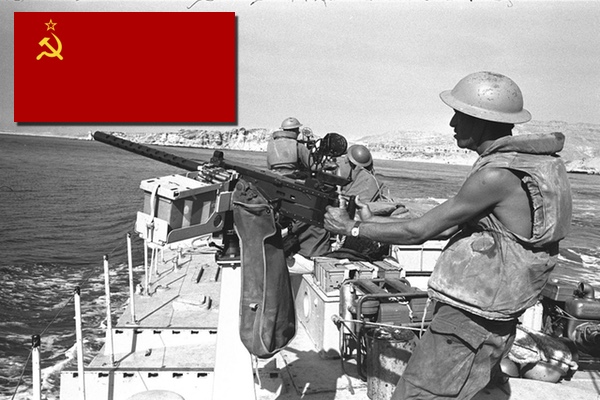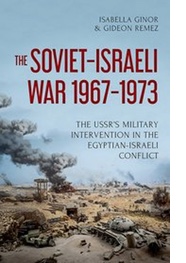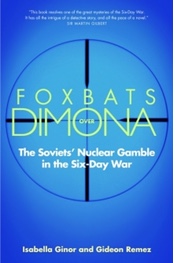How the Six-Day War became the Soviet-Israeli War

Author’s Note The following article was solicited by inFOCUS, the quarterly magazine of the Jewish Policy Center, which in turn is affiliated with the Republican Jewish Coalition (RJC) and with which I had no previous connection. I agreed, after my condition was accepted that the article would be published as submitted, despite my warning that it would compare US response during and after the Six-Day War with present-day policy, and would be “very critical.” The editor considered that some of my remarks might contravene her outfit's tax-exempt status, but once I rephrased – not retracted – them, she welcomed the piece as “terrific.” However, the publisher– who is the RJC’s executive director – stipulated that two passages be deleted (I’ll leave it to the reader to guess which). I declined and withdrew the article. It is reproduced here in its entirety.
Just before the recent U.S. election, the late Russian UN ambassador, Vitaly Churkin, opined that "the general situation” between the two powers was “the worst since 1973." As then, the direct trigger was Middle Eastern. In 2016 it was “serious differences over Syria,” where post-Soviet Russia launched a ruthless military intervention; in 1973, it was the Soviet Union’s support for the attack that its clients Egypt and Syria launched against Israel on Yom Kippur.
 How
deliberate and massive that support was, and how closely the present
Russian modus operandi approximates the Soviet model, is just now
coming to light. The forthcoming book that I co-authored with
Isabella Ginor (The
Soviet-Israeli War, 1967-1973; Hurst/Oxford University Press,
2017) demonstrates that Egypt’s
1973 offensive was the culmination of a systematic joint effort with
the USSR to elaborate strategy and implement preparations on the
ground. This Soviet-Egyptian drive for revanche began within hours of
the loss of Sinai to Israel in June 1967. At the USSR intervention’s
peak in 1969-70, it threw a total of some 50,000 Soviet regulars into
direct combat with Israel, in the War of Attrition that turned the
Suez Canal into the hottest front of the Cold War. And yet the
ensuing onslaught in ‘73 took both Israel and the United States by
utter – and, for Israel, disastrous – surprise. Figuring out how
this happened demands a survey of Soviet activity from the 1967
crisis and war. The latter’s 50th anniversary is an appropriate
time for such a reassessment, especially in view of the analogies,
however imperfect, with the present situation that Churkin pointed
out.
How
deliberate and massive that support was, and how closely the present
Russian modus operandi approximates the Soviet model, is just now
coming to light. The forthcoming book that I co-authored with
Isabella Ginor (The
Soviet-Israeli War, 1967-1973; Hurst/Oxford University Press,
2017) demonstrates that Egypt’s
1973 offensive was the culmination of a systematic joint effort with
the USSR to elaborate strategy and implement preparations on the
ground. This Soviet-Egyptian drive for revanche began within hours of
the loss of Sinai to Israel in June 1967. At the USSR intervention’s
peak in 1969-70, it threw a total of some 50,000 Soviet regulars into
direct combat with Israel, in the War of Attrition that turned the
Suez Canal into the hottest front of the Cold War. And yet the
ensuing onslaught in ‘73 took both Israel and the United States by
utter – and, for Israel, disastrous – surprise. Figuring out how
this happened demands a survey of Soviet activity from the 1967
crisis and war. The latter’s 50th anniversary is an appropriate
time for such a reassessment, especially in view of the analogies,
however imperfect, with the present situation that Churkin pointed
out.
How little was hitherto known can be exemplified by a quiz: Who was Petr Nikolaevich Lashchenko? We’re sure that the name means nothing to you, because – thanks to Google – we can state that he is never mentioned in existing historiography, or declassified intelligence reports. But the memoirs of those thousands of Soviet veterans – a new genre of sources that we introduced into western scholarship – portray Lt.-Gen. Lashchenko reverently. After he took part in putting down the East German uprising in 1953 and commanded the suppression of the Hungarian revolt in 1956, he arrived in Cairo a week after its debacle in what was for Egypt the three-day war.
 As
Isabella and I showed in our previous book, Foxbats
over Dimona: The Soviets’ Nuclear Gamble in the Six-Day War
(Yale, 2007), the Soviets had
deliberately provoked that war and prepared a limited but potentially
decisive intervention, including aerial bombings and a naval landing
in Israel, to ensure an Arab victory. The spectacular success of
Israel’s preemptive air strike on 5 June 1967 obviated most of the
plan. The only Soviet naval force to come ashore, a marine company
that tried to cross the canal eastward as the Egyptian army fled
westward, was decimated by Israeli planes. But the rest of the
landing was just put on hold – and threatened over the hotline to
Washington on 10 June, this time as a deterrent (which worked) to
halt Israel’s advance into Syria.
As
Isabella and I showed in our previous book, Foxbats
over Dimona: The Soviets’ Nuclear Gamble in the Six-Day War
(Yale, 2007), the Soviets had
deliberately provoked that war and prepared a limited but potentially
decisive intervention, including aerial bombings and a naval landing
in Israel, to ensure an Arab victory. The spectacular success of
Israel’s preemptive air strike on 5 June 1967 obviated most of the
plan. The only Soviet naval force to come ashore, a marine company
that tried to cross the canal eastward as the Egyptian army fled
westward, was decimated by Israeli planes. But the rest of the
landing was just put on hold – and threatened over the hotline to
Washington on 10 June, this time as a deterrent (which worked) to
halt Israel’s advance into Syria.
Moscow’s failure to rescue the clients it had armed and abetted touched off remonstration throughout the Arab world and other Soviet allies. Both to preserve its hegemony and to redeem the reputation of its weaponry, Moscow had to double down on its support and treat the defeat as just one battle in a continuing war. There was a genuine emotional dimension: comparison with the Nazi assault on the USSR in 1941, and the urge to repel it, were rife among the now-senior Soviet diplomats and officers who had fought through “the Great Patriotic War.” Egypt’s leaders, first Gamal Abdel Nasser and then Anwar Sadat, needed the promise of a military feat to regain “sacred Egyptian soil” for their political survival.
By the time Lashchenko arrived in Cairo, a vast Soviet sea- and airlift had begun to replace Egypt’s lost weaponry. Soviet military doctrine indicated that the Israelis, having reached the canal, would cross it to maximize their momentum by marching on a defenseless Egyptian capital. Lashchenko’s boss, the elderly and ailing Chief of Staff Matvey Zakharov, inspired the Egyptians by digging himself a foxhole, and established a classic Soviet three-tiered fortification line on the canal’s west bank.
Lashchenko had a longer-term mission: slated to remain in Egypt as head of a Soviet military group, he began to devise a counterattack across the canal – the plan that was in the main implemented in 1973. For this task he was especially well equipped: he was made a Hero of the Soviet Union for leading his outfit across water obstacles in World War II. Not all of Lashchenko’s ideas turned out well: his recommendation to divide the front between two Egyptian army corps created the cusp through which the Israelis made their counter-crossing that reversed the course of the war. But overall, Lashchenko’s blueprint worked: his training program that called for cross-canal infantry raids and artillery duels as live-fire exercises, regardless of casualties, did exorcise the Egyptians’ dread of Israeli invincibility. The weapons list that he drew up and Moscow provided, including the latest anti-tank and anti-aircraft systems, proved likewise essential.
But most importantly from Moscow’s viewpoint, this time the Soviets resolved that their best hardware should not be squandered again due to what they considered inept misuse. Through the summer of ’67, Lashchenko negotiated a fundamental enhancement of Soviet standing in the Egyptian military. The number of advisers was multiplied, with direct access to field units and quasi-command authority. Egyptian ports and airbases became Soviet bases in all but name. As Churkin recognized, Soviet strategic presence in the Eastern Mediterranean was launched toward its all-time acme – which Putin is now striving to restore.
Just as the USSR wasn’t in Egypt only to fight Israel, Russia isn’t in Syria today – pace Donald Trump – to fight ISIS in common cause with America. It’s there to prop up Bashar Assad’s regime in order to protect the Russian foothold that he provides, with Latakia and Tartus analogous to Nasser’s Alexandria and Port Said. Out of the latter port on 21 October 1967, the day Lashchenko’s agreement was signed, the Soviets “all but pressed the button” to fire the Styx missiles than sank the Israeli destroyer Eilat – the first such kill in naval annals. The challenge to the US Sixth Fleet became palpable, and Soviet-Egyptian commitment to a military redress of the 1967 rout was cemented. Diplomatic wrangling about a peace agreement would henceforth serve as a smokescreen.
How did America and the West let this happen, after the USSR’s ostensible setback in ‘67? The following seven years spanned two doomed US presidencies – an adjective that is already popping up with reference to Donald Trump’s. In the run-up to the Six-Day War, as it unfolded and in its aftermath, as Lyndon Johnson sank deeper into the Vietnam quagmire, any sympathy he felt for Israel was hobbled by mortal fear of another imbroglio, even when the Israelis warned about the Soviet’s grand design. His State Department was trying in vain to curb Israel’s nuclear project – a central motive, as we found, for the Soviets’ instigation of the 1967 war – and to gain Israeli accession to the Non-Proliferation Treaty (opened for signature in July 1968; Israel has not signed). The American diplomats tried to use Israel’s prime weapons request, F-4 Phantom jets, as a bargaining chip. Johnson demurred, settled for Israel’s no-first-introduction ambiguity that still stands, and in one of his last acts as president approved the Phantom sale. But his administration also bequeathed to Richard Nixon’s a perennial excuse for inaction: the spin, still ensconced in most histories, whereby the Soviets were restraining Egypt – telling Nasser not to attack Israel at all, when they actually were telling him not yet, until all was ready.
In 1969, “the Nixinger model of realpolitik” became the order of the day. The composite name reflected, as Nixon sank deeper toward impeachment, the gradual fusion of his own vindictive paranoia (which led him into the leak-plumbing scandal) and his mendaciousness (that turned it into Watergate), with the ascendant Henry Kissinger’s aspirations and conceit, into a toxic narcissism. How eerily familiar that now seems.
I temporized on finalizing this comment as long as the deadline [1 March] allowed, in the hope that by then the fog would lift on what is being dubbed Putingate. It hasn’t lifted much yet, but the bookies are already giving almost even money on wagers that Trump will be impeached. Besides impeachment, the scenarios of 25th-amendment removal or resignation have also come into play in betting parlors.
On the night that I sat down to write, another piece of the puzzle was reported: a “back-channel deal” between Trump’s attorney, his now-disavowed Russian-thug henchman, and a pro-Russian Ukrainian faction to circumvent and undermine declared US policy. “Back-channel”? I was gobsmacked by a sudden insight why not only the Russian operation in Syria gives me an acute sense of déjà vu (the concluding sentence of our new book), but also Trump’s response. His repeated justification for cultivating Putin is a simplified but essentially faithful rendition of Kissinger’s rationale for his signature policy, Détente – for which the central instrument was a “back channel” to Moscow, via the Soviet Ambassador Anatoly Dobrynin.
Nixon and Kissinger were never suspected of being bribed by Moscow, or blackmailed by means of kompromat (compromising material) or financial dependence. Still, as we found, the Russians repeatedly took advantage of Kissinger’s ego and insatiable urge for self-aggrandizement, with Israel on the receiving end. They certainly would be able to so exploit a president on whom they have the goods, but who believes that he, as master deal maker, can maneuver them to his benefit.
From their first meeting, Dobrynin reported to Moscow that Kissinger was “quite vain, not averse to boasting, without excessive modesty” – in which he saw an opportunity. The Soviets went on to make the most of it, assisted by Kissinger’s supercilious confidence that Dobrynin’s “comprehension is imperfect.” As Kissinger’s grip on Nixon’s policy tightened, the Soviets ambushed him time after time with moves on the Egyptian-Israeli front that he believed he had talked them out of. They led him either to believe or to knowingly propagate false claims – now known as “alternative facts” – that bolstered Soviet-Egyptian propaganda or deception.
This was aided by Kissinger’s pleas to keep the back-channel deals secret from other U.S. officialdom – especially Secretary of State William Rogers, whose Mideast initiatives he undermined and whom he eventually supplanted; from American Jews, who he feared might aim their supposed control of the media – aka “fake news” – against him or even assassinate him for the concessions these deals would demand from Israel; and above all, to hide the back-channel agreements from Israel itself. This enabled the Soviets to double-cross him with impunity time and again:
● Kissinger was infuriated by the discovery in March 1970 that an entire, integral Soviet division – SAM batteries, fighter squadrons and other units – had been dispatched to Egypt months earlier, to shore up its defenses until its own crews could be trained.
● After the toll the Soviets took on Israel’s Phantoms and pilots forced Israel to accept a ceasefire in August 1970, neither the US nor Israel could do anything when the Soviets immediately violated it by advancing the SAM shield to the canal bank, creating the precondition for Egypt’s ultimate crossing.
● Once the Soviet regulars’ mission had been accomplished, they were withdrawn in a three-way agreement that the Soviets worked out separately with Sadat and with Kissinger, and finalized with the latter at the Moscow Summit of May 1972. This was the last obstacle to the apotheosis of Détente at the summit, and in order to overcome it Kissinger was constrained to make major concessions – such as accepting the Soviet reading of Security Council Resolution 242 as requiring Israeli withdrawal from all the occupied territories.
● He then had to echo and perpetuate the deceptive Egyptian line that Sadat “expelled the Soviet advisers” in a rift with Moscow over its refusal to provide offensive weapons. None of this actually occurred: the advisers remained to continue preparations for the canal crossing, and the weapons were all supplied. But the “expulsion” myth too hardened first into Israel’s notorious “Concept,” whereby Egypt could not go to war for lack of superpower support. Later the “expulsion” was installed as unassailable fact in conventional historiography by the early publication of Kissinger’s memoirs and the books of Egyptian propagandist Mohammed Hassanein Heikal.
And yet Kissinger was blindsided almost as badly as Israel in October 1973. Early on Yom Kippur, alerted to Israeli reports of the Egyptian onslaught, he hastened to call Dobrynin – and got a rude awakening from any illusion about their years of camaraderie over vodka and caviar:
K: This is very important for our relationship, that we do not have an explosion in the Middle East right now.
D: What is our relationship?
Within weeks, the relationship descended into the near-nuclear confrontation that Churkin alluded to.
Egypt did ultimately switch to the American camp when Sadat, having vindicated Egyptian military glory, needed America for the peace as much as he needed the USSR for the war. But this was only after Israel suffered a lasting national trauma with over 2,200 fatalities. It wasn’t the only victim: other fruits of Détente, such as the Vietnam accord that won Kissinger the Nobel Peace Prize, also turned to ashes. Even assuming that the depiction of Trump as a Russian stooge is never borne out, his seeming mutual-admiration-society with Putin is bound to meet the same end. Fifty years after the Six-Day War raised the curtain on this drama, one can only hope that its repeat performance – for Israel and America – won’t be another tragedy instead of the proverbial farce.